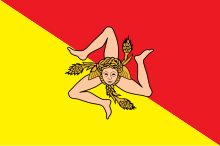Flag of Sicily
The flag of Sicily has existed since the Sicilian Vespers in 1282, when Sicily rebelled against the rule of Charles I of Anjou .
The background is divided diagonally into red and yellow. In the middle of a will Triskele presented with a decorated head, along the typical Sicily Trinacria .
In February 2000 the flag was declared the official regional flag, representing Sicily in front of all public buildings.
symbolism
The color red symbolizes the city of Palermo to this day , the color yellow stands for the city of Corleone , which was the agricultural center of Sicily in the 13th century. These two cities were the first to form an alliance against Charles I and campaign for the independence of Sicily.
The triskele shows three running legs in the form of an equilateral triangle and is an ancient symbol for the sun or the path of life. It is also shown, for example, on the flag of the Isle of Man and in the coat of arms of the city of Füssen .
Together with a head in the middle, the symbol was called Trinacria or "three-leggedness", and the term became the former name of Sicily, the island with the three corner points. Images of the Trinacria have been around since ancient times. One of the oldest can be seen in Tindari as a floor mosaic, another on a rock in the Villa Giulia Park in Palermo.
The head in the middle first represented the head of Medusa , a figure with serpentine hair from Greek mythology. In later versions the head of Ceres , the Roman goddess of agriculture, was depicted. The ears of wheat symbolized fertility, the wings were reminiscent of Hermes , the messenger of the gods.
The trinacria with the head in the middle is still a typical symbol of Sicily and can be seen everywhere on the island. It not only adorns the flag, but is also made as a piece of jewelry made of gold or silver, as a wall decoration made of clay or wood.
